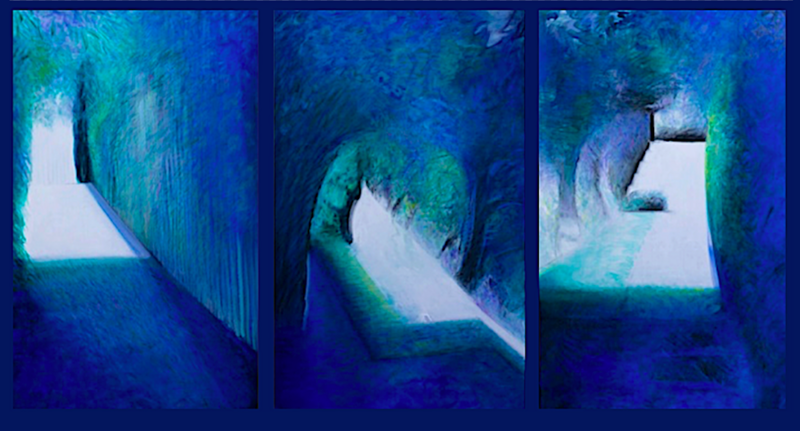Chemins Éclairés (Paths of Light)

Anne Madden
Oil on canvas, 76¾ x 133½." The O'Brien Collection.
Anne Madden was born in Chile in 1932. Her father was Irish, her mother Anglo-Chilean, and they moved to England when she was about four. Ireland became important as she visited her father’s relations in Co. Clare with him, discovering and spending time in the Burren, thereafter a landscape of central imaginative importance to her. In 1950, she injured her spine badly in a riding accident, necessitating serious surgery. When she and her partner, artist Louis le Brocquy moved to France, it was largely because the climate was more amenable to healing her bones.
From the 1950s onwards, Madden’s exceptionally ambitious paintings fuse elements of the extraordinary Burren (Co. Clare) environment, its vast skies, limestone pavement and stone monuments, with the techniques and scale of American abstraction. Gradually her range of reference diversified to encompass the city of Pompeii, some classical mythic narratives, Odyssean voyages, the Aurora borealis and her beloved second home, France.
If mortality and mourning have been consistent underlying concerns, so too is a sense of creative possibility and wonder, and a rapt appreciation of beauty. (Adams, Dublin).
The illuminated paths in Anne Madden’s triptych are, figuratively, paths of light leading from the darkness of grief to acceptance and peace; they are also depictions of an actual path, aglow amidst the enveloping shade of the garden, the path to her studio. The studio, which she shared with Louis le Brocquy, was built in 1962 at their home, Les Combes, in the foothills of the Alps above Nice. Les Combes, and specifically the studio, was the centre of their daily life for close to three decades before they returned to settle in Ireland in 2000. Tragedy, mourning and recovery are a recurring theme in her life and her art.
“Madden’s father died in a car crash when she was a teenager. Later, her sister and brother-in-law died in a plane crash, leaving three young children for whom Madden became guardian. Her brother Jeremy, also as a young man, died in a domestic accident, fatally injuring himself falling down a stairs….. Ghastly things,” she says. “It’s all still there, I don’t know what life is like without all that, but tragedy does live with you, it goes along with you. You don’t get rid of it.”
In 1984, Madden was devastated by the sudden death of her younger, much-loved brother, Jeremy Madden Simpson. Over the following years, she found herself adrift again in mourning. She likened it to being confined in a dark room, and eventually felt that she was in exile from the studio; painting held no appeal. Talking to her friend and neighbor, Samuel Beckett in 1987, she explained her predicament. He later wrote to her saying that she must deal with the darkness, express it, rather than trying to elude it. She took his words to heart, compiling a volume of Jeremy’s writings - and trying to find her way back to the studio.
This process engendered a number of paintings partly built around the metaphorical opposition of Light and Dark. Light was the possibility of life, hope, creativity; Darkness was the state of being cut off from all of those things. The studio for her is not just an atelier, a workshop, it is the center of life, a generative space. The illuminated path is a way out of darkness, back to life in all its contingency and promise.
Where can I learn more about the artist of the subject?
Wonderful RTE Documentary-Anne Madden: Painter and Muse--https://www.youtube.com/watch?v=sn8Gyc_LtKk
Poetic Reflection: an “inside-out” reflection on loss and grief
Enda Wyley: The Soul Kisses Goodbye ( from Socrates in the Garden, 1998)
I am the soul
who leaves your body
but at the door comes back
to kiss you once
then, lonely, comes back
again and again,
my grief, jagged petals falling
on the floor of your mouth
that was always mine.
Again and again, I turn
to trawl the water caves
of your mind
where your lovers
have often drowned
trying, one last time, to catch
all those thoughts
you so assuredly pouched
in your eyes now fallen
to a desperate close.
Twice, three times
I become,
where the devil of pain
tries to dig its claws,
an angel at rest
on shoulders—
a definite breeze
cooling down the heat of
of your people’s loss.
They lift their heads
from the side of your bed
gone suddenly cold
and feel me kissing
your body goodbye,
over and over—
you who harboured me
so well in life
with love. *
*(Based on an old Irish story (“An t-anam a phóg an corp”) where the soul, having left the body, cannot resist
turning back to kiss it farewell repeatedly, having been protected by it in life.
Musical Reflection:
Martin Hayes and Dennis Cahill- The Lament for Limerick , aka Limerick’s Lamentation (from The Lonesome Touch, 2006)
https://open.spotify.com/album/608ZQ0B9bYpnfIMmgbIN7w, Track 7
https://www.last.fm/music/Martin+Hayes+&+Dennis+Cahill/_/The+Lament+For+Limerick
“The Irish version, "Marbhna Luimní," derives its title from the siege and fall of the city of Limerick to the English forces of Ginkel in 1691, at the end of the Williamite Wars. The tune is sometimes known as "Sarsfield's Lamentation" from the name of the commander of the Irish forces at Limerick. The Irish musicologist, W.H. Grattan Flood (A History of Irish Music, 1905, p. 173), also dates the melody in Ireland to the year 1691 when the Irish were defeated by the forces of the English monarch William of Orange.” (Tunearch.org)